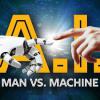
Breaking News
 The Days of Democracy Are Over
The Days of Democracy Are Over
 Elon Musk Described an AI Device to Replace Phones in 5 Years
Elon Musk Described an AI Device to Replace Phones in 5 Years
 Deposit Insurance For Billionaires?
Deposit Insurance For Billionaires?
 Rep. Troy Balderson Is Right: Coal And Gas Drive Affordable, Reliable, And Clean Energy
Rep. Troy Balderson Is Right: Coal And Gas Drive Affordable, Reliable, And Clean Energy
Top Tech News
 Graphene Dream Becomes a Reality as Miracle Material Enters Production for Better Chips, Batteries
Graphene Dream Becomes a Reality as Miracle Material Enters Production for Better Chips, Batteries
 Virtual Fencing May Allow Thousands More Cattle to Be Ranched on Land Rather Than in Barns
Virtual Fencing May Allow Thousands More Cattle to Be Ranched on Land Rather Than in Barns
 Prominent Personalities Sign Letter Seeking Ban On 'Development Of Superintelligence'
Prominent Personalities Sign Letter Seeking Ban On 'Development Of Superintelligence'
 Why 'Mirror Life' Is Causing Some Genetic Scientists To Freak Out
Why 'Mirror Life' Is Causing Some Genetic Scientists To Freak Out
 Retina e-paper promises screens 'visually indistinguishable from reality'
Retina e-paper promises screens 'visually indistinguishable from reality'
 Scientists baffled as interstellar visitor appears to reverse thrust before vanishing behind the sun
Scientists baffled as interstellar visitor appears to reverse thrust before vanishing behind the sun
 Future of Satellite of Direct to Cellphone
Future of Satellite of Direct to Cellphone
 Amazon goes nuclear with new modular reactor plant
Amazon goes nuclear with new modular reactor plant
 China Is Making 800-Mile EV Batteries. Here's Why America Can't Have Them
China Is Making 800-Mile EV Batteries. Here's Why America Can't Have Them
Aqua-Fi could bring Wi-Fi-like tech to the underwater world

Back in 2018, we heard how researchers at Saudi Arabia's King Abdullah University of Science and Technology (KAUST) had used lasers to transmit HD video through water. Their experimental new system, known as Aqua-Fi, builds on that technology.
A user such as a scuba diver would start by sending data (such as photos or videos) from a smartphone contained in a watertight housing. That data would initially be transmitted in the form of radio waves, going just a few feet to a small device mounted on the diver's air tanks.
A microcomputer in that device would then convert the data into a series of ultra-rapid light pulses, each pulse representing either a 1 or a 0 in binary code. Those pulses would subsequently be emitted towards the surface, using either an integrated 520-nanometer laser or an array of green LEDs – the LEDs could send the data relatively short distances using little power, while the laser could send it farther but would use more power to do so
Upon reaching the surface, the light pulses would be received by a photodetector on the underside of a ship, then converted back into the original photos or videos by a connected computer. From there, the files could be uploaded onto the internet via satellite.
So far, the Aqua-Fi system has been used to upload and download multimedia between two computers placed a few meters apart in still water. Before it can enter real-world use, though, it will have to be adapted to meet challenges such as the light-scattering effect of swiftly moving water – doing so may involve utilizing a spherical receiver, that could detect light pulses coming in from all directions.

 China Innovates: Transforming Sand into Paper
China Innovates: Transforming Sand into Paper

